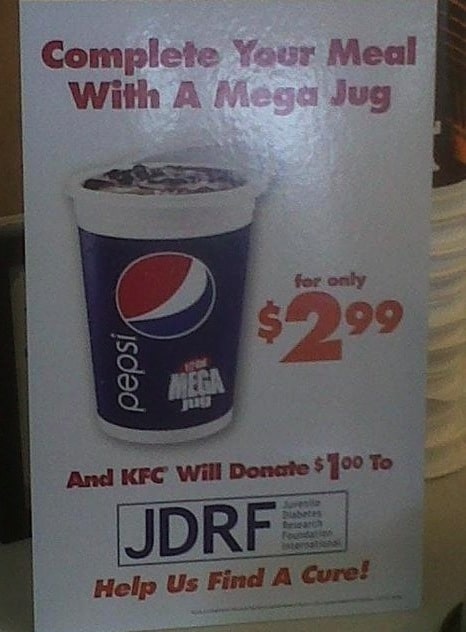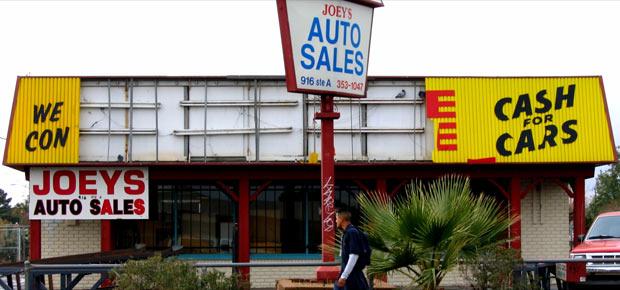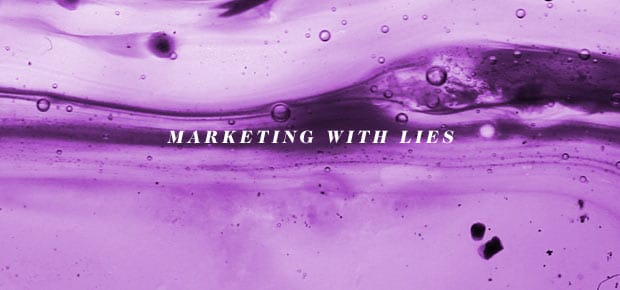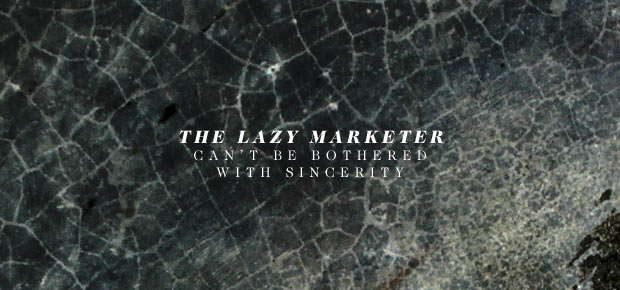I believe this came from KFC. I think about all of the people who worked on this endeavour: the person who came up with the idea, the designer who laid out the artwork, the sign maker/printer who created it, and the people who installed it. I think about them and wonder: Was the irony of selling massive servings of sugar-water to raise money for diabetes research lost on any of them?
Month: June 2011
Dealership Fails in Last Mile of Internet Campaign
Because I’m trying to sell my car, I wanted to know how much it’s worth. Many dealerships have a deal with car appraisal engine Kelley Blue Book, so that you can get an estimate on your trade-in on the dealership’s website for free. It works as a nice lead-generation tool for the dealership: I get a free appraisal on my car, and they get my contact info to try to sell me a new car.
As expected, I got a follow-up email. Here’s the body of the email, verbatim:
My name is Dale internet and sales consultant if you are wanting to sell or trade your Lancer please give me a call we are always needing vehicles that are in good condition and we pay top dollar for trades also I have a young lady looking for a car like yours so if I can help I will be happy to thanks talk with you soon
So, the dealership (one of the “big three”) spends time and money developing its brand and Internet strategy. They build a website and create YouTube videos. Everything is just right. And then this email gets sent out …
These emails should be scripted and polished. It would only take a few minutes to clean up this introductory email, so why wouldn’t the dealership bother to do it? This writing shouldn’t make its way out of sixth grade. What qualities does this email impart on the dealership’s brand?
… also I have a young lady looking for a car like yours …
Sure you do. Sure you do.
This goes back to what I’ve said a few days ago: Employees have the greatest ability to shape the brand.
Marketing with Lies
I talk about lies in marketing often—probably because I find them so offensive. It’s a little bit like hating garbage, though: It’s not hard to find these things offensive.
I received this voicemail the other day. It is (for lack of a better word) a scam. I’ve been building websites and involved in search engine listings since 1996; I know how search engines work. The things said in this voicemail range from misleading to outright false. It sounds pretty convincing, however, and if I didn’t know better, I could probably be convinced to part with some money for this snake oil.
This reminds me of the Domain Registry of Canada, a similar operation that relies on misleading marketing and half-truths for its business model. I won’t get into its operation here, but if you Google “Domain Registry of Canada scam,” you’ll turn up plenty of write-ups.
Sometimes, People Will Believe Anything
This picture—which is a hoax—has been making the rounds on Twitter lately. Brandchannel has a great write-up on this situation. Aside from the content itself being ridiculous (At the very least, why would McDonald’s alienate a large segment of the audience like that?), the phone number shown at the bottom is for the KFC headquarters.
What I find interesting about this is why people take it seriously. The main reason is that we tend to suspend disbelief when we see things like this online. We assume that someone, somewhere, has taken the time to verify this. We assume that because it exists, it must be true.
The other reason this works is that it looks legitimate:
- The typeface looks correct.
- Everything is lined up properly (with nothing centre-aligned).
- The language sounds like it came out of a head office.
In fact, the only visual clues that suggest that this isn’t legit are the masking tape sloppily tacking the sign up and the odd margins (especially on the right side of the sign).
I’ve found that you don’t have to be a designer or a marketer to be pretty savvy about what looks like legitimate communication. People are very good at sensing when things just don’t look right, at least at a very low level. This is why the email scams are appearing more and more “legitimate” nowadays. It is also why it’s so important for your collateral to be designed to reflect your brand’s promise: your audience can sense when your materials don’t reflect your message.
Brand Ambassadors: Your employees build the brand
This post at 37signals about how cutting corners can affect your brand—even if your customers don’t notice—is spot-on.
I’ve long felt that for most companies, the strongest influence on the brand is the employees. Employees deliver the richest experiences, with the highest fidelity. We form our perceptions about the brand so much more from our experiences with the brand’s workforce than through any other touchpoint. Marketing, advertising, and collateral don’t tell us nearly as much as does our interaction with the staff representing the brand.
The post (which is really worth the read) also includes this anecdote from a former employee of an Apple store:
I used to work at one of Apple’s retail stores and can totally affirm this. They do an excellent job of marketing to their own people, which just keeps the enthusiasm for the company at a constant high. And as I learned working at the store, enthusiasm is contagious; if the employees are excited about the product, the customers are going to be excited about the product as well.
You know what? I really get that vibe from Apple store employees. You can tell they’ve really bought into the products they’re selling, and that feeling rubs off onto customers. The story above contrasts quite nicely with this one about GM:
Similarly, many years ago I worked at GM headquarters. Walking into the office and trudging my way up to the cube farm—even in my daily tasks—you’d never know that GM made cars. I’ve always considered it the primary reason the American auto industry is falling apart.
If your employees aren’t enthusiastic about your product, experience, or brand, how can you expect your customers to be?
Where’s the Benefit?
Five seconds into this video, you’ll be staring in slack-jawed wonder.
I’ve worked with several new businesses that don’t seem to understand the value of this kind of presentation. There are three reasons this video works really well:
- The benefit is clear. You see it once, and you “get it.”
- It’s novel. It looks like magic.
- There is no big setup. We go straight into the good stuff.
Companies that have products like this are really easy to market.
Tell the truth, but make the truth fascinating
Tell the truth, but make the truth fascinating.”
—David Ogilvy
I love this quote, as it sums up my approach to communication perfectly. It can be found in this video from Adweek, along with many more David Ogilvy sound bites.
The lazy marketer can’t be bothered with sincerity
A printer I’ve used a few times over the years has been working hard lately to drum up new business. Someone there has heard of the rule that it’s easier to get money from people who already know you than it is to convert new customers. The company has been on a real blitz lately. Over the past month I’ve received multiple copies of the same email, and last week I received a letter—all with the exact same content.
I’ve reproduced the content of this marketing effort below, with some of the identifying information removed.
Good Afternoon Taylor Garries,
My name is [sales rep], assistant manager from [well-known printing company]. How is business going? I noticed that you haven’t ordered with us for a while and would like to do some more work with you.
I would like to update you on the following summer specials going on at [well-known printing company]:
[summer specials]
Although price is important, we know that service is much more valuable when it comes to printing. I would like to work with you on any print projects that you have coming up and I will be your dedicated rep and provide you with fast, reliable and high quality printing.
Taylor Garries, let me know when your next print job and let me quote you on it. You can contact me at [phone number] or email me at [email address].
Talk to you soon,
[sales rep]
This type of marketing is all about illusion. While I expect the advertiser to use a mail-merge form letter, I also expect the company to do a better job of creating an illusion that we genuinely enjoy a personal relationship.
The printer wanted the letter to sound like it really came from this person and was written specifically for me:
- It’s addressed to me.
- It’s written in the first person.
- It offers me a “dedicated” rep.
- It asks how my business is going.
- It mentions the importance of service.
However, the vendor did a poor job with this mail merge and the actual content of the letter (grammatical errors notwithstanding). If you’re going to write a letter to sound like you’re personally sending it to me, take the time to make it sound like you’re personally sending it to me. When you get this wrong, you end up sounding like a Nigerian prince trying to get some help with money transfer.
The sloppy work spoiled the illusion, instead reminding me that we don’t have a personal relationship and that I’m being sold to as one of thousands.
People generally don’t write letters that start with “Good Afternoon Taylor Garries.” People also rarely specify the time of day in an opening greeting of the email: you wouldn’t know when the recipient might read it. The author should have used “Dear,” the less formal “Hello,” or “Hi.”
Using the recipient’s full name also sounds awkward. The advertiser should have used either “Mr. Garries” or “Taylor.” If you’re trying to build on the fact that a relationship exists—and presumably it is a good relationship—then you should go for the less formal option. Vendors that I get along with would usually write something like, “Hi Taylor.”
And then there’s one of the closing lines: “Taylor Garries, let me know when your next print job and let me quote you on it.” Again, did no one stop to ask how this would sound?
These small but telling gaffes conflict with the tone of the letter and become glaring errors in the eyes of the reader. The vendor should have polished up the content to ensure that it reads well after the mail merge.
But then, I received this exact form letter at least three times—from three different people. Even if the content was perfect, this would have ruined the illusion of any personal communication. The company should have scrubbed its distribution list to remove duplicates. This is the biggest chore, but it would yield the biggest payoff.
Alternatively, the vendor could have dropped the concept of sending a personalised letter altogether, rewriting the letter to be less personal instead. Don’t ask me how my business is going. Don’t write in the first person. Just send out a creative piece that engages me without tricking me. I’d much rather have received that three times.
A short parable about illogical influence
Below is my favourite short story about systems that encourage us to act irrationally. This actually happened, so it is completely true.
It was 2006, I think. The economy, especially in Edmonton, was booming. I was at a party as my wife’s guest, so I didn’t know a lot of people. The host had invited a few friends from her work in the accounting department of a large and well-known local business.
As is typical whenever people from work get together outside of work, they eventually started talking about work. These people hated their jobs. I listened to them complain about their horrible work environment for twenty minutes.
Then I interjected, “Things can’t be too bad there, if you all still work there.”
They paused for a moment, and one of the women turned to me and said: “You don’t understand how bad it is. It’s so bad that our job causes miscarriages. Okay? There have been like three miscarriages this year alone!” And off they went again, talking about how their employer kills unborn babies.
“So why don’t you leave?” I asked. “Everyone in this city—every employer—is dying to get people to work for them. Why don’t you just walk across the street and work there?”
They all shook their heads. “No, I couldn’t do that,” explained the woman. “You see, I took a continuing education course a few months ago, and [my employer] paid for it. If I left, I would have to pay them back for the course. It’s in my contract.”
“How much was the course?” I inquired.
“About $500,” she replied.
So, this woman was willing to work at a job that she hated, in an environment so stressful that it causes miscarriages, because she might have to pay back $500.
Setting aside the likelihood that the workplace is truly that bad (it only matters that employees perceive it to be horrible), it’s astounding that people would forgo legitimate employment alternatives because of that amount of money. It reminds me of indentured servitude—but for what is really a small sum, or at least an amount that could be overcome relatively easily, considering the ultimate prize of having a comfortable work environment.
Such notions seem to short-circuit all reasonable thought. They’re like optical illusions that work on a much grander scale; they create blind spots in our thinking.
Ferd F-Teenthousand
This is a pretty funny sendup of the TV spots auto manufacturers use to sell pickup trucks. These things start as satire, but they inevitably end up in the actual commercials.
Trucktober. Coming to a dealership near you.







